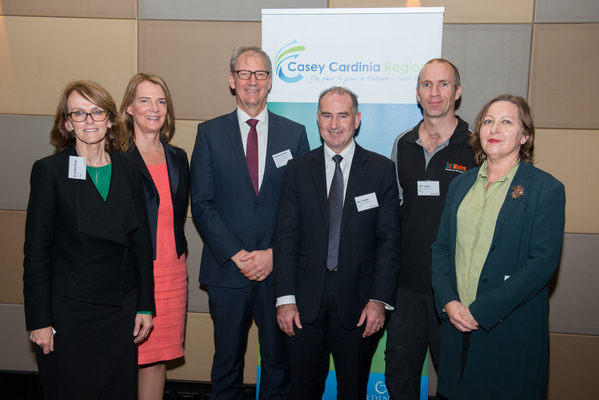
IN THE future, households won’t buy refrigerators, they will “hire cold hours” and “wearables” won’t only clothe people but monitor the environment and turn body heat into electricity.
Those were two predictions made at a manufacturing and future industries forum held at the Sofitel on Tuesday 7 June.
Sponsored by the Casey Cardinia Region, the forum featured representatives from the CSIRO, the State Government and the Australian Industry Group.
CSIRO deputy director of manufacturing Cathy Foley said in the future manufacturing would become a service industry.
She predicted the evolution of cars that would monitor how we drive with the information fed back to insurance companies and “wearables” that would monitor the environment around us, including the quality of the oxygen we breathe, directly affecting health insurance premiums.
She said the problem of clothing going to landfill would be solved by “dissolve on demand” threads and instead of buying a refrigerator, customers would purchase “cooling hours”, with the manufacturer responsible for monitoring when the appliance needed fixing and recycling it at the end of its life.
Ms Foley said these ideas were being developed now in universities and the CSIRO.
It’s a high tech future the Casey Cardinia region is keen to be a part of.
The region is making a concerted push to attract manufacturing and especially smart manufacturing in order to create jobs, cut down commute times and improve the health and wellbeing of the entire community.
Cardinia CEO Garry McQuillan said jobs and innovation were vitally important to the region, which was one of the fastest growing in Australia and would eventually boast a population the size of Canberra.
He said manufacturing accounted for more than 50 per cent of the region’s output.
“We see advanced manufacturing as crucial to the ongoing success of our economy and is directly linked to employment opportunities for our 400,000 residents of today,” he said.
“Seventy per cent of our working population leave the municipality and head to the Monash. On average they spend two hours on the Monash. Fifty per cent of the Cardinia population suffers from obesity and we have one of the highest domestic violence rates in the state. Jobs are critical.”
Chief economist with the Australian Industry Group Julie Toth said despite the demise of Australia’s auto industry and the loss of jobs in the sector, 18 per cent of manufacturing jobs or 200,000 positions had been lost since 2008, the news was not all bad.
She said the biggest growth areas were food, beverages and groceries.
Pharmaceuticals were also on a growth trajectory, as were cosmetics, toiletries and vitamin and health supplements.
“These are all areas of production where quality control is paramount and they have also benefited from the (lower) Australian dollar,” she said.
“Ten to 15 years ago, the expansion was in cars and heavy machinery. It’s more now in food and beverages.”
Ms Toth said domestic construction demand was contributing to a strong building materials, industrial textiles and furniture sectors.
She said 20,000 businesses in Australia were identified as advanced manufacturers.
Dr Michael Green, executive director of the Future Industries Project said the Casey Cardinia region was perfectly poised to become a major centre of food manufacturing.
He said the region’s location on the edge of the urban growth boundary and clean, green image was a distinct advantage
“The Casey Cardinia region has a lot of manufacturing capability and there are a lot of opportunities in the south east region.”
Mr Green said State Government investment in high velocity trains and Federal Government defence contracts were both manufacturing opportunities for the region.






